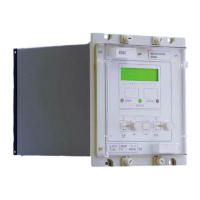VCG202/EN M/H11
Technical
4. APPLICATION OF CONTROL FUNCTIONS
The settings that customise the relay for a particular application are referred to as the
configuration. They include the function links, input masks, relay masks, etc and they are
password protected to prevent them being changed accidentally. Together these settings
select the functions that are to be made available and how they are to be interconnected.
Before the advent of integrated numerical relays, protection and control schemes
comprised individual relays that had to be interconnected and a diagram was produced to
show these interconnections. The configuration of a numerical relay is the software
equivalent of these interconnections. With the software approach, installations can be
completed in much shorter times, especially for repeat schemes, saving valuable time
and cost. A second advantage is the ability to make some changes without having to
disturb the external wiring.
Before the connection diagrams can be drawn for an installation, it will be necessary to
decide how the logic within the relay is to function. A copy of the logic diagram can be
found at the back of this manual. It should be copied and the appropriate squares in the
input and relays masks can be shaded in to show which logic inputs and output relays are
to be assigned in each mask. The function links should then be drawn on the diagram in
position “0” or “1” as required.
These software links may turn functions on, or off, and when in the “off” state
unnecessary settings will not appear in the menu. On completion of the configuration
diagrams the function link settings can then be read off the logic diagram and entered as
a series of ones and zeroes, in the boxes provided on the logic diagram.
Case connection diagrams for the KVGC202 can be found at the back of this manual.
They may be copied and notes added in the appropriate boxes to indicate the function of
the logic inputs and relay outputs. This diagram will then give the appropriate terminal
numbers to which the external wires must be connected. In particular,it will show the
terminal numbers to which the current and voltage transformer connections are to be
made.
The logic and case connection diagrams provide sufficient information to enable the full
external wiring diagrams to be drawn and the operation of complete protection and
control scheme to be understood.
4.1 Configuring the relay
Each scheme of protection and control will have its own particular configuration settings.
These can be named appropriately and the name entered as the “description” in cell 0004
in the SYSTEM DATA column of the menu. If the scheme were likely to become a
standard that is to be applied to several installations it would be worthwhile storing the
configuration on a floppy disc so that it can be downloaded to other relays.
The configuration file can be made even more useful by adding appropriate general
settings for the supervision and control functions. It will then only require the minimum of
settings to be changed during commissioning and installation.
4.2 Changing the configuration of the relay
4.2.1 SYSTEM DATA (SD)
Select the SYSTEM DATA column of the menu; enter the password and then step down
to the cell containing the SD links. Press the [+] key to put the relay into setting mode
and use to [F] key to step through the options. The option will be shown in an
abbreviated form on the top line of the display as each function link is selected. To select
an option set the link to “1” with the [+] key and to deselect it set it to “0” with the [–] key.

